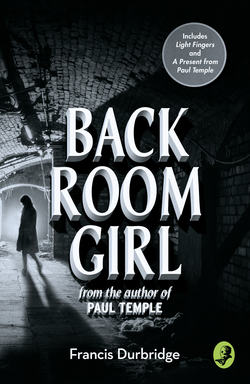Читать книгу Back Room Girl: By the author of Paul Temple - Francis Durbridge, Francis Durbridge - Страница 5
Introduction
ОглавлениеWhen Back Room Girl was published in July 1950, Francis Durbridge (1912–1998) had long been the most popular writer of mystery thrillers for BBC radio and was soon to become a ‘brand name’ on television and in the theatre. In 1938 the BBC had broadcast his serial Send for Paul Temple, and the novelist-detective and his wife Steve cemented their cult status in the sequels Paul Temple and the Front Page Men (1938), News of Paul Temple (1939), Paul Temple Intervenes (1942), Send for Paul Temple Again (1945) and many more. These first five radio serials were all novelised, published by John Long between 1938 and 1948, and most recently reissued in 2015 by Collins Crime Club.
Back Room Girl, however, was markedly different. It was Durbridge’s first book not to feature the Temples, and neither was it based on a radio serial. Instead it was an original one-off novel, which by the end of Durbridge’s writing career still compared only with The Pig-Tail Murder (1969) in this respect, although he had penned several standalone Sunday newspaper serials in the 1950s.
The Temple mysteries had invariably seen the sophisticated couple pursuing and unmasking murderers, so they all had a ‘whodunit?’ element. Back Room Girl, on the other hand, was not a detective mystery but an adventure/espionage thriller concerning skulduggery in a rural English setting. From the somewhat whimsical opening sentence, ‘It was early on the highly appropriate day of Friday that Roy Benton first saw the footprints in the sand,’ it must have been immediately obvious to any Paul Temple fan that this was not going to be typical Durbridge fare.
The year is 1947, and Fleet Street crime reporter and SAS hero Major Roy Benton begins a new life by retiring to No Man’s Cove in Cornwall to write his memoirs. He anticipates peace and quiet, but this seems increasingly unlikely when he discovers that a disused tin mine has become a research laboratory for a top secret project. He finds that the brilliant scientist Karen Silvers is heading the operation, and that his friend Chief Inspector Wilfred Leyland has been seconded from Scotland Yard because a sinister organisation is intent on stealing the plans.
The ringleader is Fabian Delouris, and he and his henchmen are Nazis (‘the worst Gestapo types’) who use extreme forms of torture to extract the information they require. ‘I have been,’ says Delouris, ‘a dealer in mass murder and the means to it for more years than I care to remember.’ This could account for the fact that Back Room Girl has not been translated and in particular has never been published in Germany, where Durbridge is otherwise a great favourite and where almost all of his novels have appeared.
The book has some themes that remain relevant today. For example, it speculates about the morality of Karen’s work on developing a weapon of mass destruction. ‘A curious way of preventing war,’ comments Roy, ‘to have a bigger stick than the other fellow, but … it’s the best we can do until we learn more sense’; whereas Karen believes that ‘This thing is so deadly, so devastating, that its very existence ought to prevent anyone ever going to war again.’ Underlying the story is also an element of surprise that a woman has been put in such a powerful position, although feisty Karen has always believed that ‘men had been merely people with whom she had to work because there weren’t enough women scientists.’
Back Room Girl therefore showed Durbridge in a new and unusual light, and he followed it up with two more novels that appeared to continue his move away from Paul Temple. But this was illusory, as Beware of Johnny Washington (April 1951) was a re-write of his first novel Send for Paul Temple, with some plot changes and a new set of characters without Paul and Steve, while Design for Murder (November 1951) was a novelisation of his 1946 radio serial Paul Temple and the Gregory Affair, but again with new characters instead of the Temples. (Both books, originally published by John Long and out of print for over sixty-five years, have now finally also been reissued.)
A key factor in Durbridge’s success as an entertainer, however, was his astuteness in recognising what his audience wanted. For the rest of his career as a novelist, apart from his standalone The Pig-Tail Murder, he concentrated on two reliable publishing categories. The first was the Paul Temple mysteries, which resumed in 1957 until 1988, of which five were based on his radio serials and three were original novels: The Tyler Mystery (1957), Paul Temple and the Harkdale Robbery and Paul Temple and the Kelby Affair (both 1970). The second category was adaptations of his phenomenally popular television serials, sixteen of which he novelised between 1958 and 1982. There were also two further instances of nifty recycling when Durbridge turned the radio serials Paul Temple and the Gilbert Case and Paul Temple and the Jonathan Mystery into the non-Temple novels Another Woman’s Shoes (1965) and Dead to the World (1967).
It transpired that Durbridge never again wrote a novel that resembled Back Room Girl in any way. Truly a one-off, it is a book that few among his legion of fans will have had the opportunity to read until now. The bonus short stories ‘Light-Fingers’ and ‘A Present from Paul Temple’ at the back of this book will be similarly unfamiliar to the modern audience. They appeared in consecutive editions of the Daily Mail Annual for Boys and Girls in 1950 and 1951, shortly after the publication of Back Room Girl, and show the lighter side of Francis Durbridge writing for younger followers of his radio series.
MELVYN BARNES May 2017
